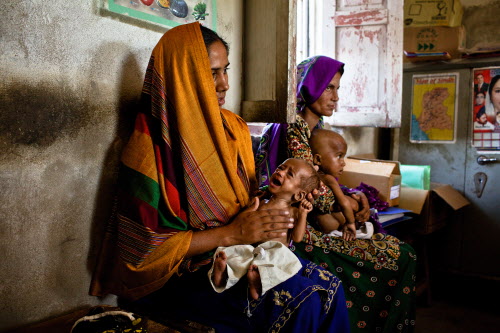For Reshman Khatoon, getting professional medical treatment is a luxury. A 25-year-old stay-at-home mother from a small village in Khairpur District, Pakistan, she and her three children live off her husband’s meager daily wages. Although he works long, hard hours, the money he earns is barely enough to support them.
Consequently, Reshman only visited a private clinic once for an antenatal checkup during her most recent pregnancy. She constantly felt weak and eventually developed anemia. At 32 weeks, she gave birth at home to a baby boy they named Qadir Bux.
His parents’ concern for their newborn began immediately. Qadir did not have the strength to breastfeed. To keep him warm, his grandmother wrapped him in a cotton sheet, and tried to feed him buffalo milk with a spoon.
But Qadir did not take to the milk. After a few days, they were so alarmed by his deterioration that they rushed him to the hospital – the Gambat Institute of Medical Sciences (GIMS) – nearly 22 kilometers (13 miles) away.

Thankfully, the hospital has a Kangaroo Mother Care (KMC) ward, set up as a pilot site under USAID’s Maternal and Child Health Integrated Program (MCHIP). KMC is a low-cost intervention for premature and low birth weight newborns. It is recommended by the World Health Organization for the routine care of newborns weighing 2,000 g (4.4 lbs) or less at birth.
The practice involves thermal care through continuous contact with the infant tied to the chest of the caregiver, support for exclusive breastfeeding or other appropriate feeding, and early recognition and response to complications. Yet despite its potential, KMC introduction and practice in Pakistan has been limited.
To expand its coverage and uptake, MCHIP introduced KMC pilot sites in two hospitals in Sindh province: Khairpur and Shikarpur. And for little Qadir – who arrived to an MCHIP-supported site at four days old and only 1.3 kg (less than 3 lbs) – access to this care was lifesaving.
Dr. Bakhtiar Ahmed, head of pediatrics and an MCHIP trained KMC master trainer, recommended KMC for Qadir. Samina Bhatti, a KMC counselor, explained the procedure to Reshman and her family through illustrated charts and videos. Initially, Reshman was hesitant to practice skin-to-skin care with her newborn, but by the end of the first day, she felt comfortable with the practice.
For the first two days of their stay, while Qadir gradually developed a suckling reflex, Bhatti also taught Reshman how to express and feed him breast milk. “I felt my baby very close to me. I felt his breathing and touch,” Reshman said. “It made me happy to keep my baby next to me.”

Through continuous encouragement, counseling, and the provision of essential supplies during their stay at the KMC ward, Reshman and her family became aware of the importance of KMC practices and feeding Qadir breast milk. By the end of his week in the KMC ward, he was drawing milk from his mother’s breast, was more active – and had gained 1.8 kg (almost 4 lbs)!
But Bhatti’s vital role in Qadir’s recovery went beyond counseling his parents to initiate KMC practice – she also encouraged them to continue the practice at home along with exclusive breastfeeding.
The MCHIP-supported providers at GIMS gave Qadir the best possible care for his condition: his parents’ skin-to-skin care, warmth and feeding. “I would recommend and encourage all fathers to be involved in KMC practices,” Reshman’s husband said. “I think KMC is very important for the survival of newborns.”
This post is a cross-post from the Maternal and Child Health Integrated Program (MCHIP).
